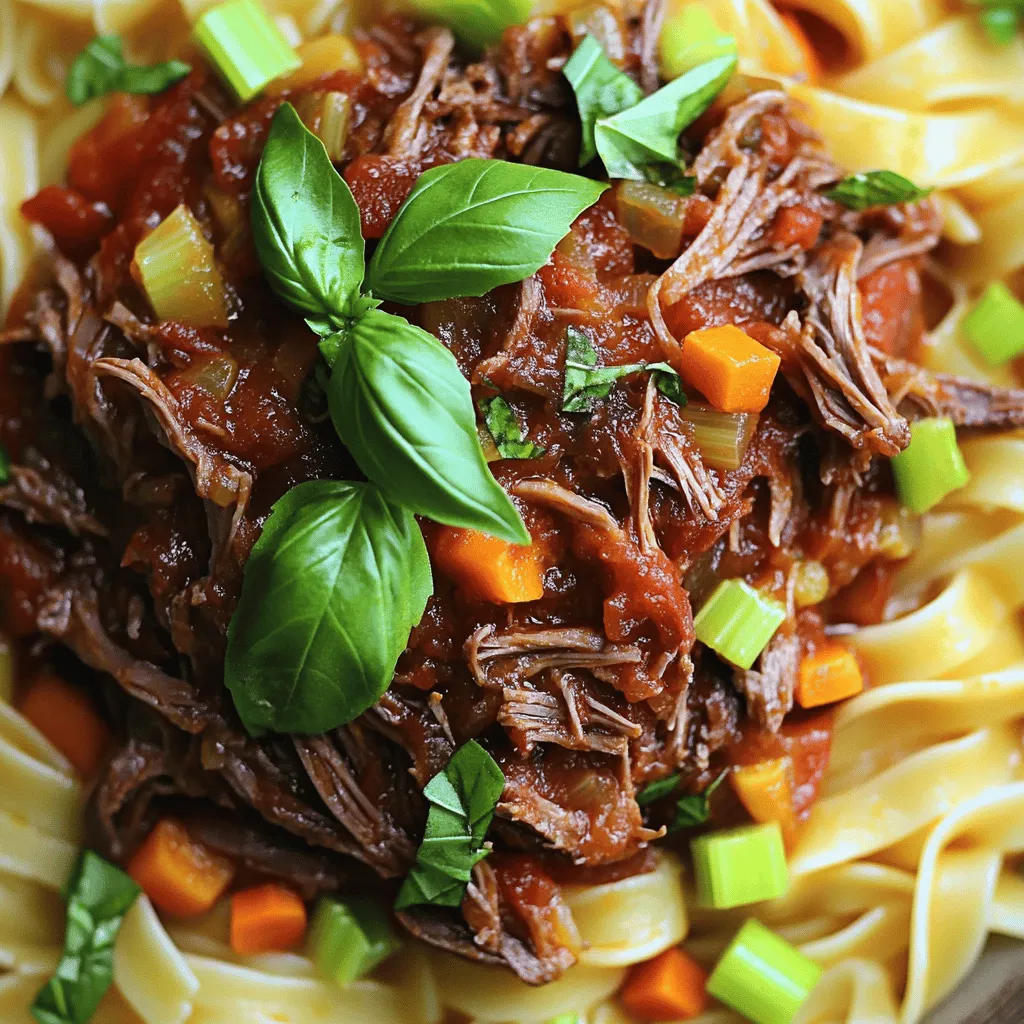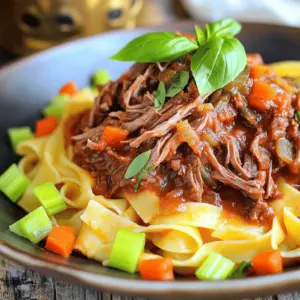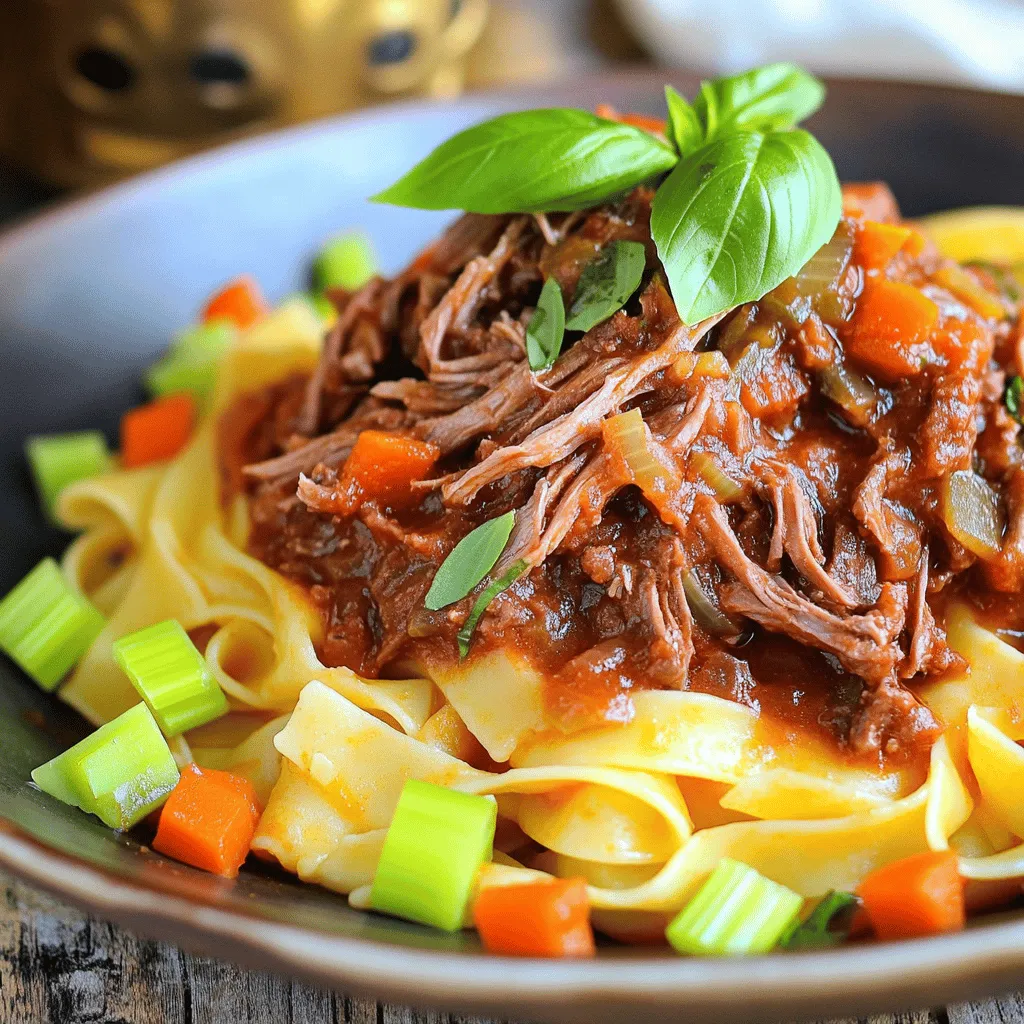Looking for a pasta dish that warms the heart and fills the belly? Let me introduce you to Slow-Simmered Short Rib Ragu! This rich, savory sauce combines tender beef, fresh veggies, and essential herbs. You’ll learn how to achieve perfect short ribs and discover tips to enhance flavor. With easy steps and helpful storage ideas, this recipe will turn dinner into a cozy celebration. Ready to dive in and savor every bite?
Ingredients
Main Ingredients
– 2 lbs bone-in beef short ribs
– 1 large onion, finely chopped
– 2 medium carrots, finely diced
– 2 celery stalks, finely diced
– 4 cloves garlic, minced
– 1 can (14 oz) crushed tomatoes
– 3 cups beef broth
– 2 tablespoons olive oil
– 1 tablespoon tomato paste
– 1 teaspoon dried oregano
– 1 teaspoon dried basil
– Salt and pepper to taste
The star of this dish is the bone-in beef short ribs. Their rich flavor makes the ragu deep and hearty. Fresh vegetables add sweetness and depth. Use a large onion, carrots, and celery for the best base. Garlic brings an aromatic touch that makes the dish sing. The crushed tomatoes and beef broth provide moisture and body. Tomato paste adds a punch of flavor, while herbs like oregano and basil enhance the taste. Don’t forget to season with salt and pepper to bring out all the flavors.
Optional Ingredients
– Tagliatelle, pappardelle, or rigatoni pasta
For a richer ragu, you might consider adding red wine. It deepens the flavor and adds complexity. You can also swap the beef broth for chicken broth if you prefer a lighter taste. Choose pasta shapes like tagliatelle, pappardelle, or rigatoni. Their textures hold the sauce well, making every bite a treat.
Garnishing Elements
– Fresh basil leaves
– Grated Parmesan cheese
Garnishing your dish is important. Fresh basil leaves add a bright touch and lovely aroma. Grated Parmesan cheese provides a salty depth that rounds out the dish. Sprinkle these over your pasta before serving for a beautiful and flavorful finish.
Step-by-Step Instructions
Preparing the Short Ribs
Searing the short ribs
To start, heat olive oil in a large Dutch oven. Season the short ribs with salt and pepper. Once the oil is hot, add the ribs. Sear them for about 3-4 minutes on each side. This step adds a rich flavor.
Importance of seasoning
Seasoning is key. It enhances the meat’s taste. Don’t skip this step. Proper seasoning helps build layers of flavor in your dish.
Cooking the Base
Sautéing vegetables
Next, use the same pot to sauté chopped onion, diced carrots, and diced celery. Cook these for 5-7 minutes. Stir them often until they soften and turn translucent. This forms a flavorful base for the ragu.
Adding garlic for flavor
Now, add minced garlic to the pot. Sauté it for 1-2 minutes. Garlic brings a warm and inviting aroma. It deepens the overall flavor of the sauce.
Combining Ingredients
Reintroducing ribs and mixing in herbs
Return the seared ribs to the pot. Stir in tomato paste, dried oregano, and basil. Mix everything well. These herbs add a fresh, aromatic touch.
Ensuring even coating with tomatoes and broth
Pour in crushed tomatoes and beef broth. Make sure everything is evenly coated. This gives the ragu its rich, saucy texture.
Slow-Simmering Process
Setting up for a long cook
Bring the pot to a gentle simmer. Cover it with a lid and reduce the heat to low. Let it cook for 3-4 hours. This slow process allows the flavors to develop fully.
Tips for turning the ribs
During cooking, turn the ribs halfway through. This ensures they cook evenly. Tender meat is the goal here.
Shredding and Combining Meat
Removing bones and excess fat
When cooking is done, take the ribs out of the sauce. Place them on a cutting board. Let them cool a bit, then remove the bones and excess fat.
Integrating shredded beef into the sauce
Shred the meat using a fork. Return the shredded beef to the sauce. Stir well to combine everything. This helps the meat absorb all those delicious flavors.
Serving Suggestions
Cooking pasta to perfection
While the ragu finishes cooking, boil your pasta. Follow the package instructions until it’s al dente. Drain it well before serving.
Presentation tips for serving
Serve the pasta in shallow bowls. Top it with the rich ragu. Garnish with fresh basil for color and flavor. Optionally, add grated Parmesan for a creamy finish. Enjoy this hearty dish with friends and family!
Tips & Tricks
Achieving Tender Short Ribs
To get tender short ribs, slow cooking is key. This method breaks down tough fibers in the meat. Use a heavy pot like a Dutch oven to keep heat steady. Sear each side of the ribs well for flavor. Cook them for about 3 to 4 hours on low heat. Turning the ribs halfway helps them cook evenly.
Enhancing Flavor Profiles
Adding seasonings can boost the taste. I like using dried oregano and basil in the recipe. These herbs add great depth. For a sweet contrast, balance acidity from tomatoes with a touch of sugar. You can also add a splash of balsamic vinegar for a rich layer.
Cooking Equipment Recommendations
A Dutch oven is the best choice for slow simmering. Its thick walls retain heat well. Don’t skip the lid! Keeping it on helps maintain moisture and flavor. This way, your ragu stays rich and thick, ready to coat your pasta perfectly.

Variations
Ingredient Substitutions
If you can’t find beef short ribs, you can use other meats. Try chuck roast or brisket. These cuts cook well and give great flavor. For a lighter option, consider using turkey or chicken thighs. They will still make a tasty ragu.
You can also swap the vegetables. If you prefer, use bell peppers or zucchini. These choices add different flavors. If you need a vegetarian dish, try mushrooms or lentils. These will give your ragu a rich taste.
Sauce Variations
To make your ragu even better, add red wine. A splash of dry red wine can deepen the flavor. It adds a nice richness that balances the meat.
You can also change the herbs. Instead of oregano and basil, try thyme or rosemary. These herbs bring fresh notes that brighten the dish. Experimenting with flavors can lead to fun surprises.
Serving Style Variations
Your choice of pasta can change the meal. Tagliatelle is nice and wide, holding the sauce well. Pappardelle is another great choice for richness. If you want something different, try rigatoni or even gnocchi.
For gluten-free options, use gluten-free pasta. Many brands offer delicious choices that taste great. You can also serve the ragu over polenta or rice. These options make for satisfying meals without gluten.
Storage Info
Refrigeration Instructions
To store your leftover ragu, place it in an airtight container. Let it cool to room temperature before sealing. This helps keep the ragu fresh and safe. You can store it in the fridge for up to three days. If you want it to last longer, consider freezing it.
Freezing Guidelines
To freeze the ragu, first, let it cool completely. Then, transfer it to a freezer-safe container. Make sure to leave some space at the top as the ragu will expand when frozen. It can stay in the freezer for up to three months. To thaw, move it to the fridge overnight. You can also thaw it in the microwave if you’re in a hurry.
Reheating Tips
When reheating, use a pot on low heat. Stir often to keep the ragu from sticking. You can add a splash of beef broth or water to help maintain moisture. Avoid using high heat, as it can dry out the ragu. Serve it warm over your favorite pasta for a delicious meal.
FAQs
How long do I need to simmer the ragu?
You should simmer the ragu for 3 to 4 hours. This time is key for the meat to soften. A long simmer helps the flavors mix well. The sauce will also thicken and become rich. Without enough time, the meat may stay tough. Simmering breaks down the collagen in the meat. This gives you that melt-in-your-mouth texture.
Can I use boneless short ribs instead?
Yes, you can use boneless short ribs. They will cook faster than bone-in ribs. However, they may not have as much flavor. Bone-in ribs add depth to the ragu. If you use boneless, adjust the cooking time. Keep an eye on them to avoid overcooking. The goal is tender meat that shreds easily.
What pasta works best with short rib ragu?
Tagliatelle, pappardelle, or rigatoni works great. These pastas hold the sauce well. Their shapes catch the ragu, giving you a full bite. Choose the pasta you enjoy most. Cook it al dente to add a nice texture. The pasta should complement the rich sauce. It’s all about balance in flavors and textures.
How do I know when the ribs are done?
Look for the meat to be very tender. It should pull away easily from the bone. Use a fork to test this. If it shreds easily, the ribs are ready. You can also check the sauce. It should be thick and full of flavor. The long cooking time makes all the difference here.
In this post, we explored how to prepare a delicious short rib ragu. You learned about the main ingredients, optional flavors, and garnishes. We shared step-by-step instructions to help you cook tender, rich meat. Plus, we added tips to enhance flavors and recommendations for substitutes and storage.
Cooking can be simple and fun. With these insights, you can create a dish that impresses everyone. Enjoy making your ragu, and don’t forget to tweak it to fit your taste!

